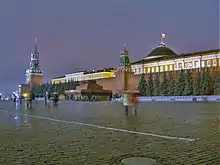Administrative divisions of Moscow
The federal city of Moscow, Russia is divided into administrative districts called administrative okrugs, which are a subdivision of state administration. They are further divided into municipal formations called districts (raions) and settlements (poseleniy), which are local self-government entities.
| Federal city of Moscow, Russia | 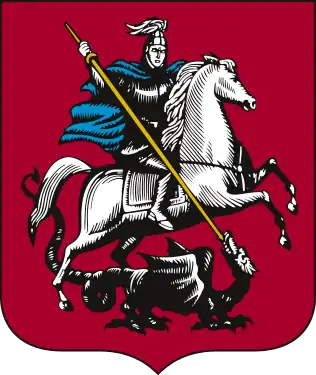 |
|---|---|
| As of July 1, 2012: | |
| # of city administrative okrugs (административных округов) | 12 |
| # of administrative districts (районы) | 125 |
| # of administrative settlements (поселения) | 21 |
| # of municipal formations (intra-city territories of a federal city) | 146 |
| # of municipal okrugs (муниципальных округов) | 125 |
| # of municipal settlements (муниципальных поселения) | 19 |
| # of urban okrugs (городских округов) | 2 |
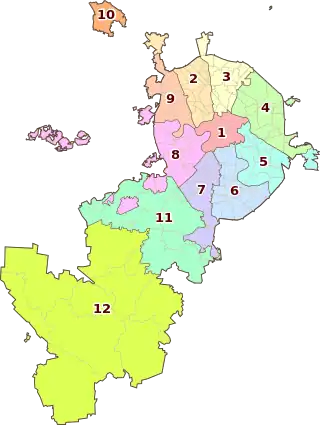
- Central Administrative Okrug
- Northern Administrative Okrug
- North-Eastern Administrative Okrug
- Eastern Administrative Okrug
- South-Eastern Administrative Okrug
- Southern Administrative Okrug
- South-Western Administrative Okrug
- Western Administrative Okrug
- North-Western Administrative Okrug
- Zelenogradsky Administrative Okrug
- Novomoskovsky Administrative Okrug
- Troitsky Administrative Okrug
Overview
Administratively, the city is divided into 12 administrative okrugs, which in turn are subdivided into 146 administrative units, which include 125 administrative districts and 21 administrative settlements. Municipally, each of the 146 administrative units have municipal status as 125 municipal okrugs, 19 municipal settlements, and 2 urban okrugs.[1] The municipalities of Shcherbinka and Troitsk are styled "urban okrugs" due to their former municipal status within the territory in Moscow Oblast which became New Moscow.
The city does not have a downtown area; the urban core is scattered across the city. Prominent business areas include Tverskoy, Arbat, and Presnensky Districts (the latter being home to the Moscow-City complex). Central Administrative Okrug as a whole has a large concentration of businesses. The city hall and major administration buildings are located in Tverskoy District (home to the Moscow Kremlin). Western Administrative Okrug is home to Moscow State University, Sparrow Hills and Mosfilm Studios, while North-Eastern hosts Ostankino Tower and VDNKh Exhibition Park. The total population of the Federal City of Moscow was 11,503,501 inhabitants at the Russian Census (2010).
On July 1, 2012, Moscow's land area grew by 1,490 sq km (580 sq mi), taking in territory from Moscow Oblast and called New Moscow.[2]
Administrative okrugs
Central Administrative Okrug
The territory of Kitay-gorod is not a part of any district and is governed directly by the administrative okrug.
| Name | Population[3] | Photos |
|---|---|---|
| Central Administrative Okrug (Центральный административный округ, Tsentralny administrativny okrug) | 701,353 | 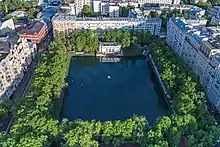 Patriarshy Ponds  Central Okrug districts |
| Districts under the central administrative krug jurisdiction: | ||
|
25,699 | |
|
100,899 | |
|
97,110 | |
|
45,229 | |
|
56,077 | |
|
116,979 | |
|
109,993 | |
|
75,955 | |
|
22,822 | |
|
50,590 | |
Northern Administrative Okrug
| Name | Population[3] | Photos |
|---|---|---|
| Northern Administrative Okrug (Северный административный округ, Severny administrativny okrug) | 1,112,846 |  Leningradsky Prospect runs through the Northern Administrative District. 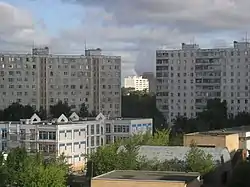 Dmitrovsky 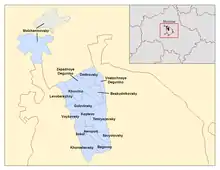 Northern Okrug districts |
| Districts under the administrative okrug jurisdiction: | ||
|
74,775 | |
|
44,385 | |
|
74,790 | |
|
88,931 | |
|
102,160 | |
|
55,949 | |
|
79,092 | |
|
97,989 | |
|
51,309 | |
|
2,929 | |
|
57,814 | |
|
57,317 | |
|
84,098 | |
|
97,083 | |
|
67,470 | |
|
76,756 | |
North-Eastern Administrative Okrug
| Name | Population[3] | Photos |
|---|---|---|
| North-Eastern Administrative Okrug (Северо-Восточный административный округ, Severo-Vostochny administrativny okrug) | 1,240,062 |
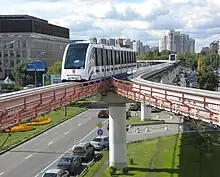 The Moscow Monorail Transit System operates in the North-Eastern Administrative Okrug. 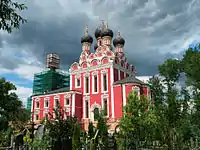 Tikhvinskaya Church in Alexeyevskoye 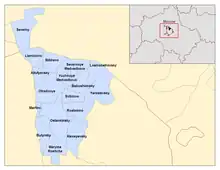 North Eastern Okrug districts |
| Districts under the administrative okrug jurisdiction: | ||
|
73,429 | |
|
50,091 | |
|
77,491 | |
|
151,334 | |
|
60,922 | |
|
76,465 | |
|
72,640 | |
|
23,971 | |
|
60,194 | |
|
57,707 | |
|
168,972 | |
|
35,134 | |
|
111,804 | |
|
9,629 | |
|
52,824 | |
|
84,739 | |
|
72,716 | |
Eastern Administrative Okrug
| Name | Population[3] | |
|---|---|---|
| Eastern Administrative Okrug (Восточный административный округ, Vostochny administrativny okrug) | 1,394,497 | 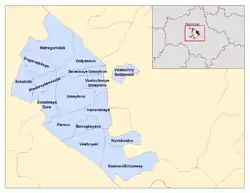 Eastern Okrug districts  Losiny Ostrov National Park is partially within the Eastern Administrative Okrug |
| Districts under the administrative okrug jurisdiction: | ||
|
98,602 | |
|
159,147 | |
|
127,905 | |
|
110,099 | |
|
16,917 | |
|
37,283 | |
|
95,183 | |
|
97,927 | |
|
135,095 | |
|
80,827 | |
|
80,785 | |
|
85,056 | |
|
54,975 | |
|
126,546 | |
|
75,450 | |
|
12,700 | |
South-Eastern Administrative Okrug
| Name | Population[3] | |
|---|---|---|
| South-Eastern Administrative Okrug (Юго-Восточный административный округ, Yugo-Vostochny administrativny okrug) | 1,116,924 | 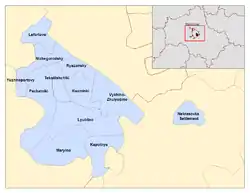 South Eastern Okrug districts 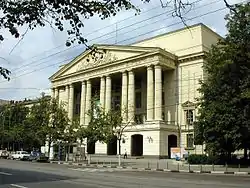 Moscow Power Engineering Institute building |
| Districts under the administrative okrug jurisdiction: | ||
|
27,828 | |
|
122,951 | |
|
87,560 | |
|
132,331 | |
|
206,388 | |
|
7,803 | |
|
38,756 | |
|
71,383 | |
|
89,270 | |
|
87,849 | |
|
184,749 | |
|
60,056 | |
Southern Administrative Okrug
| Name | Population[3] | |
|---|---|---|
| Southern Administrative Okrug (Южный административный округ, Yuzhny administrativny okrug) | 1,593,065 |  Southern Okrug districts 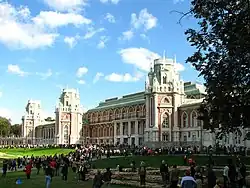 Tsaritsyno Grand Palace |
| Districts under the administrative okrug jurisdiction: | ||
|
129,700 | |
|
83,303 | |
|
94,644 | |
|
104,613 | |
|
104,042 | |
|
133,008 | |
|
90,265 | |
|
45,477 | |
|
67,257 | |
|
69,031 | |
|
105,948 | |
|
69,535 | |
|
121,402 | |
|
137,965 | |
|
115,708 | |
|
121,197 | |
South-Western Administrative Okrug
| Name | Population[3] | |
|---|---|---|
| South-Western Administrative Okrug (Юго-Западный административный округ, Yugo-Zapadny administrativny okrug) | 1,179,211 | 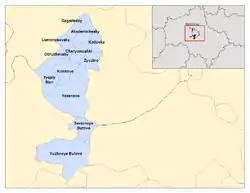 South Western Okrug districts |
| Districts under the administrative okrug jurisdiction: | ||
|
96,172 | |
|
89,264 | |
|
72,072 | |
|
138,757 | |
|
58,666 | |
|
81,851 | |
|
63,484 | |
|
75,045 | |
|
112,733 | |
|
174,236 | |
|
105,212 | |
|
111,719 | |
Western Administrative Okrug
| Name | Population[3] | Photos |
|---|---|---|
| Western Administrative Okrug (Западный административный округ, Zapadny administrativny okrug) | 1,049,104 | 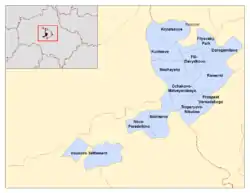 Western Okrug districts |
| Districts under the administrative okrug jurisdiction: | ||
|
59,732 | |
|
66,775 | |
|
92,965 | |
|
76,261 | |
|
125,100 | |
|
109,248 | |
|
86,755 | |
|
90,576 | |
|
56,564 | |
|
101,485 | |
|
85,642 | |
|
77,901 | |
|
20,100 | |
North-Western Administrative Okrug
| Name | Population[3] | Photos |
|---|---|---|
| North-Western Administrative Okrug (Северо-Западный административный округ, Severo-Zapadny administrativny okrug) | 779,965 | 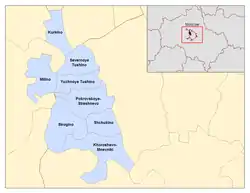 North Western Okrug districts |
| Districts under the administrative okrug jurisdiction: | ||
|
146,968 | |
|
2,339 | |
|
138,371 | |
|
46,707 | |
|
138,533 | |
|
89,454 | |
|
124,149 | |
|
93,444 | |
Zelenogradsky Administrative Okrug
| Name | Population[3] | Photos |
|---|---|---|
| City of Zelenograd (город Зеленоград, Gorod Zelenograd) | 215,727 | 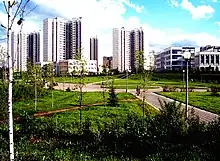 16th microdistrict of Zelenograd (Kryukovo District) 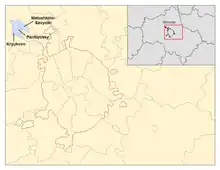 Zelenograd districts |
| Districts under the administrative okrug jurisdiction: | ||
|
||
|
||
|
||
|
||
|
73,481 | |
Novomoskovsky Administrative Okrug
| Name | Population | Photos |
|---|---|---|
| Novomoskovsky Administrative Okrug (Новомосковский административный округ, Novomoskovsky administrativny okrug) | 113,569 | 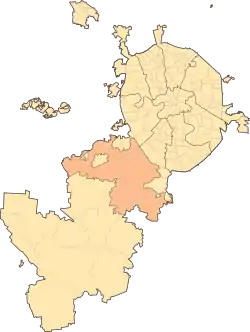 Novomoskovsky Administrative Okrug |
| Settlements under the administrative okrug jurisdiction: | ||
|
||
|
||
|
||
|
||
|
||
|
||
|
||
|
||
|
||
|
||
|
||
Troitsky Administrative Okrug
| Name | Population | Photos |
|---|---|---|
| Troitsky Administrative Okrug (Троицкий административный округ, Troitsky administrativny okrug) | 86,752 | 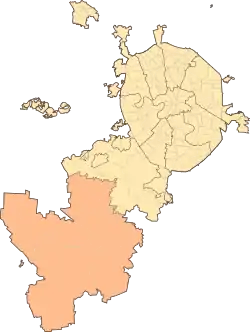 Troitsky Administrative Okrug |
| Settlements under the administrative okrug jurisdiction: | ||
|
||
|
||
|
||
|
||
|
||
|
||
|
||
|
||
|
||
|
||
Territorial units with special status
Former territorial units with special status (Russian: территориальная единица с особым статусом, ТЕОС) which existed in 1995–2002, and were not part of the districts in which they were located:
- Bitsevsky Park
- Izmaylovsky Park
- Losiny Ostrov
- Sokolniki Park
- ZIL
- Zelenogradskaya
- Moscow State University
- Sheremetyevsky
- Southwestern Center of Science and Industry
- Vodny Stadion
- Moscow-City
- Kuzminki–Lyublino
- Kitay-gorod
All territorial units with special status were merged into districts in 2002.
History

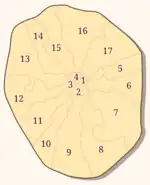
Russian Soviet Federative Socialist Republic
- 1917–1920
In 1917 Moscow was divided into 8 districts. In October 1917 Moscow was divided into 11 districts.
- 1920–1936
In 1936 Moscow was divided into 7 districts.
- 1936–1960
In 1936 Moscow was divided into 23 districts.
- 1960–1969
In 1960 Moscow was divided into 17 districts.
- 1969–1991
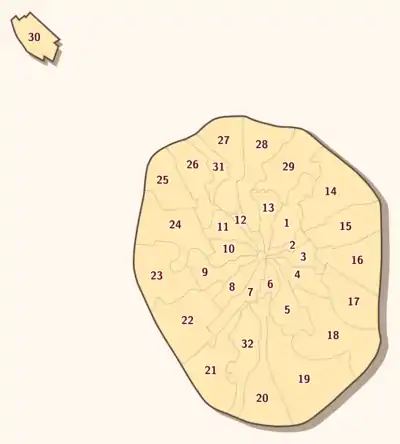
In 1969 Moscow was divided into 30 districts:
- Central part of Moscow
- Sokolnichesky
- Baumansky
- Kalininsky
- Zhdanovsky
- Proletarsky
- Moskvoretsky
- Oktyabrsky
- Leninsky
- Kievsky
- Krasnopresnensky
- Frunzensky
- Sverdlovsky
- Dzerzhinsky
- Other districts within the Moscow Ring Road
- Kuybyshevsky
- Pervomaysky
- Perovsky
- Volgogradsky
- Lyublinsky
- Krasnogvardeysky
- Sovetsky
- Cheryomushkinsky
- Gagarinsky
- Kuntsevsky
- Khoroshyovsky (later renamed Voroshilovsky, and then back to Khoroshyovsky)
- Tushinsky
- Leningradsky
- Timiryazevsky
- Kirovsky
- Babushkinsky
- outside the Moscow Ring Road:
- Zelenogradsky
In 1977, Zheleznodorozhny and Sevastopolsky Districts were established.[4] Sevastopolsky District was split off Sovetsky and Cheryomushkinsky Districts, whereas Zheleznodorozhny District was split off Kirovsky and Timiryazevsky Districts.
In 1984, a number of localities which previously belonged to Moscow Oblast were appended to Moscow. In particular, the town of Solntsevo was transferred to Moscow, and Solntsevsky District was established.[4]
Russian Federation
Parts of Moscow Oblast's territory, including the towns of Troitsk, Moskovsky, and Shcherbinka, as well as parts of the territories of Leninsky, Naro-Fominsky, and Podolsky Districts, were transferred to Moscow on July 1, 2012. The new territories have been organized into two new administrative okrugs—Novomoskovsky and Troitsky.[5]
References
- "О территориальном делении города Москвы (с изменениями на 26 июня 2013 года)". Kodeks.ru. Retrieved 30 September 2022.
- Nielsen, Rachel. "Putin Backs Moscow Expansion". The Moscow Times. Derk Sauer. Retrieved 15 October 2022.
- All population figures are as of 2002 Census.
- Прокуратуре города Москвы - 80 лет! (in Russian). Северное Измайлово, официальный сайт района. Archived from the original on 26 November 2013. Retrieved 16 July 2013.
- Official website of the Government of Moscow. Map of Moscow boundary expansion and List of municipal areas transferred to Moscow Archived June 14, 2012, at the Wayback Machine
